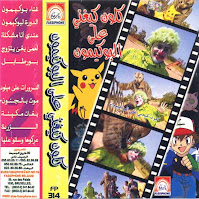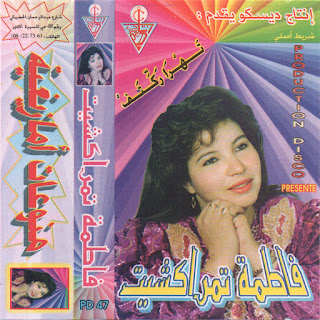When "Gnawa" is on the package, you never know what you'll find inside.
I recently obtained this 45 rpm 7" record. It likely dates from the early 1970s. Sure, it looks like it would contain a recording of a Gnawa group from a performance at the storied Festival des Arts Populaires (commonly known as the Folklore festival). Gnawa groups perform regularly at this Marrakech festival, including the Ismkhan - Amazigh-speaking Gnawa groups, always clad in white foqia robes, like the group pictured on the sleeve of this record.
Like these guys:
Sure, that would be logical. But who is this, and why is he on the back of the sleeve?
Saddik Jaghalef? Who is this man? Why is he pictured in dapper fashion with cuff links, bow tie, and cigarette? One assumes he's not part of the Gnawa troupe. Is he on the flip side of the record? Gnawa on side A and Saddik on side B? Why does the front list catalog number MB 797 while the back lists MB 798? Maybe the labels on the record will clarify?
Side A reads اڭناوة - أهازيج مغربية which translates as Gnawa - Moroccan Songs. Side B reads just أڭناوة Gnaoua. And both sides show catalog number MB 797, so maybe this is simply the Gnawa folkloric troupe from the festival and this Saddik Jaghalef is on another disc MB 798. Let's take a listen...
The opening announcement says Istouanat Boussiphone, Jghalef Sddik - that's the name of the record label, Edition Boussiphone, and the vocalist's name, Jghalef Saddik. A group of people shout out something unintelligible, and what follows is possibly the worst excuse for a Gnawa record I've ever heard.
There's one qarqaba player and one person playing a tbel barrel drum. And there's a call and response vocal between Saddik and a mixed-gender group of vocalists. Saddik sings all the lyrics on the same pitch, and the group responds on the same pitch, when they even sing in pitch. When the "singing" stops and the drums keep going, the vocalists become audience members cheering on the action. At some moments the qarqaba and drum accent a note, then rest for a couple of beats as if they were responding to the movements of Gnawa dancers.
This is a fake Gnawa record. That is, it is a recording of people pretending to be Gnawa musicians pretending to perform in front of an audience at the Folklore Festival in Marrakech. The "song" features a couple of lyrics that can be found in Gnawa songs: Lalla takul lhayma/Sidi yakul chhayma comes from "Khali Mbara Meskin", and the choral reply "a bam bam bara" comes from the song "Sudani Minitara"
Sudani Minitara might be the perfect song for a fake Gnawa record - it features arguably the most exotic aspect of Gnawa lyrics - the fact that some words are the remnants of non-Arabic languages spoken by the sub-Saharan forbears of the Gnawa. Jghalef Saddik doesn't sing the main lyrics one typically hears in Sudani Minitara, but it doesn't matter much, since most people who hear the song receive its lyrics as nonsense. "A Bam Bam Bara" does make an easy singalong for crowd participation:
By the second song of this 4-track EP, all Gnawa pretenses have been dropped, and we are simply listening to a novelty record. "Dyal Ba" sounds like something a Marrakchi tkitikate group might sing if they only had one tbel, one pair of qarqabas, and nobody knew any real songs so they just started saying the googly things that adult humans say to babies. And by side B we've moved on to pseudo-Latin Dance singalongs Baila La Bamba and Cha Cha Cha Malika. The group is singing actual pitched notes now, but it doesn't really improve the vibe. Saddik does throw a "Sudani" or "Gnawi" into the lyric here and there, but it's still just nonsense. By the end of side B he is singing a romantic melody in Arabic, French and English: Ya Habibi, Mon Amour, Ya Habibi, I Love You...
This was still early days in the endeavor of recording sounds onto physical media and calling them Gnawa, and apparently you could get away with releasing something like this and calling it Gnawa. What was Boussiphone thinking when they put this out? What was the intended audience for the record, and would this have satisfied their expectations? A clue may be the fact that it is marketed as a recording from the Folklore "Fistival". I don't know the exact date of this record's release, but I would place it sometime in the early-to-mid-1970s. According to the website of the Festival des Arts Populaires, Gnawa groups only began performing at the Festival in 1974. So perhaps this record is trying to capitalize on that recent addition.
[Aside - it blows me away that Gnawa groups were not featured in the Folklore Fest before 1974. By that year, Nass el Ghiwane and Jil Jilala had raised awareness about the cultural value of Gnawa music by incorporating the sintir and Gnawa melodies into their highly popular music. I wonder whether Gnawa's entry into the Folklore Festival was a response to this popular reevaluation!]
I could find no mention of Jaghalef Saddik anywhere online, outside of these 2 EPs on Boussiphone. According to what has been catalogued at Discogs, two discs were released with the same sleeve: MB 797 and MB 798. So if you seek more from this recording session, there's more to be had. Also, there is an alternate sleeve shown on Discogs - it looks like Saddik wearing some sort of Gnawi headgear, yet also sporting a turtleneck sweater.
By the way, the photo of the Gnawa group on the sleeve appears to be from the 1940s, according to the Maison de la Photographie de Marrakech.
This blogpost is Part One - I have at least one other example to share of a recording that purports to be of Gnawa but which is also a fake recording. I'll get around to it eventually. Don't worry, there's more actual good music coming too.
😂
Saddik Jaghalef
Gnaouas ڭناوا
Fistival De Marrakech - Folklore Marocain
Boussiphone MB 797
45 RPM, 7"
Side A label reads:
اڭناوة
أهازيج مغربية
Side B label reads:
أڭناوة
Gnaoua
From listening, here is my breakdown of tracks:
announcement : "Istouanate Boussiphone, Jghalef Sdik"
A1) Bam Bam Bara
A2) Dyal Ba
announcement: "La Bamba!"
B1) Baila La Bamba
B2) Cha Cha Cha Malika







